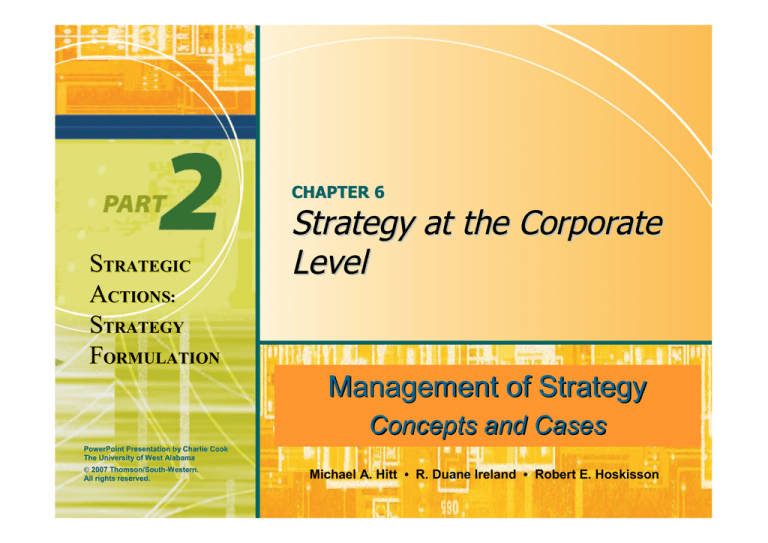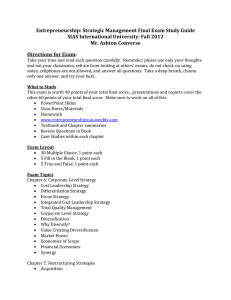
CHAPTER 6
STRATEGIC
ACTIONS:
STRATEGY
FORMULATION
PowerPoint Presentation by Charlie Cook
The University of West Alabama
© 2007 Thomson/SouthThomson/South-Western.
All rights reserved.
Strategy at the Corporate
Level
Strategic
Management
Management
of Strategy
Competitiveness and Globalization:
Concepts
Seventh edition
Concepts
and Cases and Cases
Michael A. Hitt •R. Duane Ireland •Robert E. Hoskisson
KNOWLEDGE OBJECTIVES
Studying this chapter should provide you with the strategic
management knowledge needed to:
1. Define corporate-level strategy and discuss its purpose.
2. Describe different levels of diversification with different corporatelevel strategies.
3. Explain three primary reasons firms diversify.
4. Describe how firms can create value by using a related
diversification strategy.
5. Explain the two ways value can be created with an unrelated
diversification strategy.
6. Discuss the incentives and resources that encourage
diversification.
7. Describe motives that can encourage managers to overdiversify a
firm.
© 2007 Thomson/South-Western. All rights reserved.
6–2
The Role of Diversification
•Diversification strategies play a major role in the
behavior of large firms.
•Product diversification concerns:
The scope of the industries and markets in which the
firm competes.
How managers buy, create and sell different
businesses to match skills and strengths with
opportunities presented to the firm.
© 2007 Thomson/South-Western. All rights reserved.
6–3
Two Strategy Levels
•Business-level Strategy (Competitive)
Each business unit in a diversified firm chooses a
business-level strategy as its means of competing in
individual product markets.
•Corporate-level Strategy (Companywide)
Specifies actions taken by the firm to gain a
competitive advantage by selecting and managing a
group of different businesses competing in several
industries and product markets.
© 2007 Thomson/South-Western. All rights reserved.
6–4
Corporate-Level Strategy: Key Questions
•Corporate-level Strategy’
s Value
The degree to which the businesses in the portfolio
are worth more under the management of the
company than they would be under other ownership.
What businesses should
the firm be in?
How should the corporate
office manage the
group of businesses?
Business Units
© 2007 Thomson/South-Western. All rights reserved.
6–5
Levels of Diversification: Low Level
Single Business
More than 95% of revenue
comes from a single business.
A
Dominant Business
Between 70% and 95% of
revenue comes from a single
business.
A
B
© 2007 Thomson/South-Western. All rights reserved.
6–6
Levels of Diversification: Moderate to High
•Related Constrained
Less than 70% of revenue
comes from a single
business and all
businesses share
product, technological
and distribution linkages.
•Related Linked (mixed
related and unrelated)
Less than 70% of revenue
comes from the dominant
business, and there are only
limited links between
businesses.
A
B
A
C
© 2007 Thomson/South-Western. All rights reserved.
B
C
6–7
Levels of Diversification: Very High Levels
•Unrelated Diversification
Less than 70% of revenue comes from the dominant
business, and there are no common links between
businesses.
A
B
© 2007 Thomson/South-Western. All rights reserved.
C
6–8
FIGURE
6.1
Levels and Types of Diversification
Source: Adapted from R. P. Rumelt, 1974, Strategy, Structure and Economic Performance, Boston: Harvard Business School.
© 2007 Thomson/South-Western. All rights reserved.
6–9
Table 6.1
Reasons for Diversification
Value-Creating Diversification
•Economies of scope (related
diversification)
•Sharing activities
•Transferring core competencies
•Market power (related
diversification)
•Blocking competitors through
multipoint competition
•Vertical integration
•Financial economies (unrelated
diversification)
•Efficient internal capital
allocation
•Business restructuring
© 2007 Thomson/South-Western. All rights reserved.
Value-Neutral Diversification
•Antitrust regulation
•Tax laws
•Low performance
•Uncertain future cash flows
•Risk reduction for firm
•Tangible resources
•Intangible resources
Value-Reducing
Diversification
•Diversifying managerial
employment risk
•Increasing managerial
compensation
6–10
Value-Creating Strategies of Diversification
Operational and Corporate Relatedness
High
Operational
Relatedness:
Sharing
Activities
between
Businesses
Related Constrained
Diversification
Vertical Integration
Both Operational and
Corporate Relatedness
(Market Power)
(Rare capability that creates
diseconomies of scope)
Unrelated
Diversification
Related Linked
Diversification
(Financial Economies)
(Economies of Scope)
Low
High
Low
Corporate Relatedness: Transferring Skills into
Businesses through Corporate Headquarters
© 2007 Thomson/South-Western. All rights reserved.
6–11
FIGURE
6.2
Value-Creating Diversification Strategies:
Operational and Corporate Relatedness
© 2007 Thomson/South-Western. All rights reserved.
6–12
Related Diversification
•Firm creates value by building upon or
extending:
Resources
Capabilities
Core competencies
•Economies of Scope
Cost savings that occur when a firm transfers
capabilities and competencies developed in one of its
businesses to another of its businesses.
© 2007 Thomson/South-Western. All rights reserved.
6–13
Related Diversification: Economies of Scope
•Value is created from economies of scope
through:
Operational relatedness in sharing activities
Corporate relatedness in transferring skills or
corporate core competencies among units.
•The difference between sharing activities and
transferring competencies is based on how the
resources are jointly used to create economies
of scope.
© 2007 Thomson/South-Western. All rights reserved.
6–14
Sharing Activities
•Operational Relatedness
Created by sharing either a primary activity such as
inventory delivery systems, or a support activity such
as purchasing.
Activity sharing requires sharing strategic control over
business units.
Activity sharing may create risk because businessunit ties create links between outcomes.
© 2007 Thomson/South-Western. All rights reserved.
6–15
Transferring Corporate Competencies
•Corporate Relatedness
Using complex sets of resources and capabilities to
link different businesses through managerial and
technological knowledge, experience, and expertise.
© 2007 Thomson/South-Western. All rights reserved.
6–16
Corporate Relatedness
•Creates value in two ways:
Eliminates resource duplication in the need to allocate
resources for a second unit to develop a competence
that already exists in another unit.
Provides intangible resources (resource intangibility)
that are difficult for competitors to understand and
imitate.
•A transferred intangible resource gives the unit receiving it an
immediate competitive advantage over its rivals.
© 2007 Thomson/South-Western. All rights reserved.
6–17
Related Diversification: Market Power
•Market power exists when a firm can:
Sell its products above the existing competitive level
and/or
Reduce the costs of its primary and support activities
below the competitive level.
© 2007 Thomson/South-Western. All rights reserved.
6–18
Related Diversification: Market Power
(cont’
d)
•Multipoint Competition
Two or more diversified firms simultaneously compete
in the same product areas or geographic markets.
•Vertical Integration
Backward integration—a firm produces its own inputs.
Forward integration—a firm operates its own
distribution system for delivering its outputs.
© 2007 Thomson/South-Western. All rights reserved.
6–19
Related Diversification: Complexity
•Simultaneous Operational Relatedness and
Corporate Relatedness
Involves managing two sources of knowledge
simultaneously:
•Operational forms of economies of scope
•Corporate forms of economies of scope
Many such efforts often fail because of
implementation difficulties.
© 2007 Thomson/South-Western. All rights reserved.
6–20
Unrelated Diversification
•Financial Economies
Are cost savings realized through improved
allocations of financial resources.
•Based on investments inside or outside the firm
Create value through two types of financial
economies:
•Efficient internal capital allocations
•Purchase of other corporations and the restructuring their
assets
© 2007 Thomson/South-Western. All rights reserved.
6–21
Unrelated Diversification (cont’
d)
•Efficient Internal Capital Market Allocation
Corporate office distributes capital to business
divisions to create value for overall company.
•Corporate office gains access to information about those
businesses’actual and prospective performance.
Conglomerates have a fairly short life cycle because
financial economies are more easily duplicated by
competitors than are gains from operational and
corporate relatedness.
© 2007 Thomson/South-Western. All rights reserved.
6–22
Unrelated Diversification: Restructuring
•Restructuring creates financial economies
A firm creates value by buying and selling other firms’
assets in the external market.
•Resource allocation decisions may become
complex, so success often requires:
Focus on mature, low-technology businesses.
Focus on businesses not reliant on a client
orientation.
© 2007 Thomson/South-Western. All rights reserved.
6–23
External Incentives to Diversify
Anti-trust
Legislation
• Antitrust laws in 1960s and 1970s
discouraged mergers that created
increased market power (vertical or
horizontal integration.
• Mergers in the 1960s and 1970s thus
tended to be unrelated.
• Relaxation of antitrust enforcement
results in more and larger horizontal
mergers.
• Early 2000: antitrust concerns seem to
be emerging and mergers now more
closely scrutinized.
© 2007 Thomson/South-Western. All rights reserved.
6–24
External Incentives to Diversify (cont’
d)
Anti-trust
Legislation
Tax Laws
• High tax rates on dividends cause a
corporate shift from dividends to
buying and building companies in highperformance industries.
• 1986 Tax Reform Act
Reduced individual ordinary income tax
rate from 50 to 28 percent.
Treated capital gains as ordinary
income.
Thus created incentive for shareholders
to prefer dividends to acquisition
investments.
© 2007 Thomson/South-Western. All rights reserved.
6–25
Internal Incentives to Diversify
Low
Performance
• High performance eliminates the
need for greater diversification.
• Low performance acts as
incentive for diversification.
• Firms plagued by poor
performance often take higher
risks (diversification is risky).
© 2007 Thomson/South-Western. All rights reserved.
6–26
FIGURE
6.3
The Curvilinear Relationship between
Diversification and Performance
© 2007 Thomson/South-Western. All rights reserved.
6–27
Internal Incentives to Diversify (cont’
d)
Low
Performance
Uncertain
Future Cash
Flows
•Diversification may be
defensive strategy if:
Product line matures.
Product line is threatened.
Firm is small and is in mature
or maturing industry.
© 2007 Thomson/South-Western. All rights reserved.
6–28
Internal Incentives to Diversify (cont’
d)
Low
Performance
Uncertain
Future Cash
Flows
Synergy and
Risk
Reduction
• Synergy exists when the value created
by businesses working together
exceeds the value created by them
working independently
• … but synergy creates joint
interdependence between business
units.
• A firm may become risk averse and
constrain its level of activity sharing.
• A firm may reduce level of technological
change by operating in more certain
environments.
© 2007 Thomson/South-Western. All rights reserved.
6–29
Resources and Diversification
•A firm must have both:
Incentives to diversify
The resources required to create value through
diversification—cash and tangible resources (e.g.,
plant and equipment)
•Value creation is determined more by
appropriate use of resources than by incentives
to diversify.
•Managerial Motives to Diversify
Managerial risk reduction
Desire for increased compensation
© 2007 Thomson/South-Western. All rights reserved.
6–30
FIGURE
6.4
Summary Model of the
Relationship between
Firm Performance and
Diversification
© 2007 Thomson/South-Western. All rights reserved.
Source: R. E. Hoskisson & M. A. Hitt, 1990,
Antecedents and performance outcomes of
diversification: A review and critique of theoretical
perspectives, Journal of Management, 16: 498.
6–31







